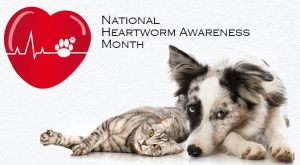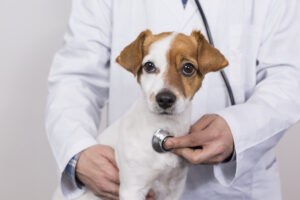Posts Tagged ‘new animal’
Winter Care for Pets: How to Keep Your Furry Friends Safe and Cozy
 As temperatures drop and the winter season settles in, it’s important to ensure your pets are prepared for the cold weather ahead. At Olsen Veterinary Clinic, we want to help you protect your four-legged family members throughout these chilly months. From safe outdoor practices to holiday hazards, we’ve gathered some essential tips to keep your pets healthy, warm, and happy all winter long.
As temperatures drop and the winter season settles in, it’s important to ensure your pets are prepared for the cold weather ahead. At Olsen Veterinary Clinic, we want to help you protect your four-legged family members throughout these chilly months. From safe outdoor practices to holiday hazards, we’ve gathered some essential tips to keep your pets healthy, warm, and happy all winter long.
Bundle Up for Outdoor Time
Even pets with thick fur can feel the effects of winter.
🐾 Limit time outside — Prolonged exposure to cold temperatures can lead to hypothermia or frostbite. Quick walks and supervised play are best.
🐾 Dress for the weather — Short-haired dogs may need sweaters or jackets to retain body heat.
🐾 Protect the paws — Salt, ice, and cold pavement can irritate paw pads. Booties or pet-safe balms can help shield sensitive feet.
🐾 Wipe down after walks — Rock salt and antifreeze are toxic! Clean paws and bellies to stop pets from licking dangerous chemicals.
Create a Cozy Indoor Environment
Winter is the perfect time to make things warm and comfortable for your pets.
🔥 Provide warm bedding — Keep beds off cold floors and away from drafts.
🍽️ Stay on top of nutrition — Some pets may burn more calories staying warm. Ask us if diet adjustments are needed.
💧 Hydrate — Pets can dehydrate in winter, too! Ensure access to fresh, unfrozen water.
🐶 Keep them active — Indoor play, puzzle toys, and short training sessions help prevent winter boredom.
Holiday Safety Tips
The festive season can bring some unexpected risks for pets.
🎄 Decorations with caution
Tinsel, ribbons, and ornaments can be choking hazards. Keep cords and candles out of reach.
🍫 Watch what they eat
Chocolate, holiday sweets, table scraps, and alcohol are dangerous for pets. Remind guests not to feed your furry friends.
🌱 Avoid toxic plants
Mistletoe, holly, and certain types of lilies can be harmful if chewed or ingested.
🎁 Safe gift-giving
Opt for pet-friendly chew toys and avoid items that could splinter or break apart easily.
Car Safety Still Matters
Cold weather doesn’t eliminate vehicle dangers.
🚗 Never leave pets unattended in vehicles
Cars can act like refrigerators, rapidly dropping to unsafe temperatures.
🐱 Check before you drive
Outdoor cats may seek warmth under your car. Tap the hood to be sure no one is hiding near the engine.
Schedule a Winter Wellness Check
Cold weather can aggravate arthritis, respiratory concerns, and other chronic conditions. A seasonal check-up at Olsen Veterinary Clinic can help ensure your pet is ready for winter.
We’re Here for You All Season Long
If you ever notice signs of frostbite, hypothermia, or sudden behavior changes, contact Olsen Veterinary Clinic right away. Winter can be a fun and cozy time for pets—with the right precautions in place!
📞 Call us today to schedule your winter wellness visit
🐾 Your pet’s health and comfort are our top priority.
Celebrating The Responsibility Of Pet Ownership: What It Means to Be a Great Pet Parent
 Responsible Pet Ownership Month is actually in February, but at Olsen Veterinary Clinic, we believe now is the perfect time to reflect on the joy pets bring to our lives—and the responsibilities that come with caring for them. Being a great pet parent goes far beyond providing food and shelter. It means committing to your pet’s health, training, and overall well-being for their entire life.
Responsible Pet Ownership Month is actually in February, but at Olsen Veterinary Clinic, we believe now is the perfect time to reflect on the joy pets bring to our lives—and the responsibilities that come with caring for them. Being a great pet parent goes far beyond providing food and shelter. It means committing to your pet’s health, training, and overall well-being for their entire life.
The Responsibilities of Pet Ownership
1. Prioritizing Healthcare
Routine veterinary care is one of the most important aspects of responsible ownership. Just like people, pets need regular check-ups to stay healthy and catch issues early. Annual wellness exams, vaccinations, parasite prevention, dental care, and senior pet check-ups all play a vital role in ensuring your pet lives a long and happy life. Preventive care not only protects your pet but also helps avoid costly emergencies down the road.
2. Providing Proper Nutrition and Exercise
Feeding your pet a balanced diet appropriate for their age, breed, and health condition is key to maintaining good health. Pairing proper nutrition with regular exercise keeps your pet physically fit and mentally stimulated. Daily walks, playtime, and enrichment activities can help prevent obesity and reduce behavioral issues.
3. Training and Socialization
Good behavior doesn’t happen overnight. Training and socialization are essential for your pet’s safety and happiness. Teaching basic commands, house manners, and positive behavior builds trust and strengthens your bond. Socializing your pet with other animals and people helps prevent fear, anxiety, and aggression, making them a well-adjusted member of the family.
4. Providing Love and Companionship
Pets thrive on love, attention, and companionship. They depend on us not just for their physical needs but also for emotional well-being. Spending quality time together through play, snuggles, or quiet companionship enriches both their life and yours.
5. Commitment for a Lifetime
Welcoming a pet into your home is a lifelong promise. Whether it’s a puppy, kitten, or senior rescue, being a responsible pet parent means committing to their care through all stages of life. This includes adjusting to their changing needs as they age.
The Reward of Responsibility
Responsible pet ownership requires dedication, but the rewards are immeasurable. In return for your care and commitment, pets offer unconditional love, loyalty, and companionship. At Olsen Veterinary Clinic, we are here to support you every step of the way with preventive care, health guidance, and resources to help you be the best pet parent you can be.
Take a moment to reflect on your role as a pet parent and celebrate the bond you share with your furry family members. Together, let’s continue building a world where every pet is healthy, happy, and loved.
Back to School Blues: Helping Pets Adjust to Schedule Changes
 As the summer days wind down and families gear up for a new school year, pets often find themselves facing sudden and unfamiliar changes in their daily routines. The shift from long, playful summer days to quieter, emptier homes can trigger confusion, stress, or even separation anxiety in our furry companions.
As the summer days wind down and families gear up for a new school year, pets often find themselves facing sudden and unfamiliar changes in their daily routines. The shift from long, playful summer days to quieter, emptier homes can trigger confusion, stress, or even separation anxiety in our furry companions.
At Olsen Veterinary Clinic, we understand how schedule changes can impact your pet’s mental and emotional well-being. Just like humans, pets thrive on routine, and any disruption—especially one as significant as the back-to-school transition—can lead to behavioral changes. Fortunately, with a few thoughtful strategies, you can help ease your pet into the new normal.
1. Gradually Adjust the Routine
Before the school year begins, start gradually shifting your pet’s schedule. Begin feeding, walking, and playing with them at times that will align with the new routine. This helps your pet adjust to the change without feeling overwhelmed when it happens all at once.
2. Create a Consistent Daily Schedule
Consistency builds comfort. Try to keep feeding times, potty breaks, and walks as consistent as possible. Even if family members are on the go, assigning pet care responsibilities ensures your pet gets the attention and structure they need each day.
3. Provide Morning and Evening Attention
Your pet may feel lonely during the day, so be sure to give them quality time in the mornings before everyone leaves and again in the evenings when the house is full again. Whether it’s a morning walk or evening cuddle, that bonding time is essential for emotional reassurance.
4. Keep Pets Stimulated While Home Alone
Prevent boredom and anxiety by leaving safe, interactive toys or treat puzzles for your pet. Calming music, pet-safe videos, or a window with a view can also keep them entertained while you’re away.
5. Practice Short Departures
In the weeks leading up to school, practice leaving the house for short periods so your pet gets used to being alone. Gradually increase the time to build your pet’s comfort and confidence with being alone during the day.
6. Consider a Pet Companion or Daycare
If your pet struggles with loneliness, consider introducing a companion (another pet, if feasible) or enrolling them in a trusted pet daycare a few times a week. Socialization and activity can help reduce stress.
7. Watch for Signs of Anxiety
Some pets may develop separation anxiety or other stress-related behaviors. Watch for signs like destructive chewing, excessive barking, accidents in the house, or changes in appetite. If you notice any concerning behaviors, don’t hesitate to contact Olsen Veterinary Clinic for guidance.
8. Use Calming Products if Needed
There are a variety of safe, vet-recommended calming products like pheromone diffusers, anxiety wraps, or natural supplements that may help soothe your pet during this transition. Ask us about what might be best for your furry friend.
The Takeaway:
Going back to school is an exciting time for families, but it can be a challenging adjustment for pets. With a bit of planning and compassion, you can help your pet transition smoothly and continue to feel safe, secure, and loved—even if their favorite humans are suddenly busier than before.
If you have questions about your pet’s behavior or need advice tailored to your pet’s personality, contact us or stop by Olsen Veterinary Clinic. We’re here to help your pet feel their best—no matter the season.
Summer Safety Tips: Keeping Your Pets Cool and Comfortable

As the temperatures rise and summer sets in, it’s important to remember that the heat can be just as uncomfortable—and even dangerous—for your pets as it is for you. At Olsen Veterinary Clinic, we care deeply about your furry family members and want to ensure they stay safe, happy, and healthy all summer long.
Here are some essential tips and advice for avoiding heat-related illnesses and keeping your pets cool during the summer months:
☀️ Understand the Risks of Heat for Pets
Unlike humans, pets don’t sweat to cool down (aside from a bit through their paws). Dogs mainly cool off by panting, and cats often rely on finding shady, cool areas. But in extreme heat, these natural cooling mechanisms may not be enough.
Heatstroke is a serious, potentially fatal condition in pets. Signs include:
- Excessive panting or drooling
- Rapid heartbeat
- Lethargy or unresponsiveness
- Vomiting or diarrhea
- Bright red or pale gums
If you suspect heatstroke, move your pet to a cool area and contact Olsen Veterinary Clinic immediately at [your clinic phone number].
🌳 Provide Shade and Fresh Water
Whether your pet is indoors or outdoors, make sure they always have access to:
- Fresh, cool water (consider adding ice cubes!)
- Shaded areas if they’re outside—trees, tarps, or doghouses with ventilation
- Cool indoor spots away from direct sunlight
Pro tip: Use a cooling mat or damp towel for your pet to lie on indoors.
🚗 Never Leave Your Pet in a Parked Car
Even with the windows cracked, the temperature inside a parked car can skyrocket in minutes. On an 85°F day, the interior can reach over 100°F in just 10 minutes. This can quickly lead to heatstroke or worse.
Leaving pets in cars is dangerous and potentially deadly. Always take them with you or leave them safely at home.
🐾 Be Mindful of Hot Pavement
If it’s too hot for your bare feet, it’s too hot for your pet’s paws. Asphalt, sand, and concrete can cause painful burns. Walk your dog early in the morning or later in the evening, and consider pet booties for extra protection.
🐕🦺 Exercise Smart
Limit intense exercise during the hottest parts of the day. Opt for short walks, indoor play, or water activities like kiddie pools or sprinklers.
Some breeds—like pugs, bulldogs, and Persian cats—are more prone to heatstroke due to their short noses and breathing difficulties. Take extra care with these pets.
🍦 Cool Treat Ideas
Give your pets a summer treat:
- Frozen dog-safe fruits like watermelon or blueberries
- Ice cubes with treats or peanut butter inside
- Pet-safe frozen yogurt or broth popsicles
Always check ingredients to ensure they’re safe for your specific pet!
🏡 Know Your Pet’s Limits
Every animal is different. Older pets, overweight pets, and those with medical conditions may struggle more with heat. Watch for signs of discomfort and adjust their routines accordingly.
😎 Stay Cool with Olsen Veterinary Clinic
If you have concerns about your pet’s health in the heat, or want personalized advice for your pet this summer, don’t hesitate to contact us. We’re here to help you enjoy the season safely with your furry companions!
April is National Heartworm Awareness Month: What Pet Owners Need to Know
 At Olsen Veterinary Clinic, we believe that knowledge is the first step in protecting your pets. That’s why we’re highlighting National Heartworm Awareness Month this April — a crucial time to educate pet owners on how to prevent and treat this potentially deadly disease in dogs and cats.
At Olsen Veterinary Clinic, we believe that knowledge is the first step in protecting your pets. That’s why we’re highlighting National Heartworm Awareness Month this April — a crucial time to educate pet owners on how to prevent and treat this potentially deadly disease in dogs and cats.
What is Heartworm Disease?
Heartworm disease is a serious and sometimes fatal condition caused by parasitic worms (Dirofilaria immitis) that live in the heart, lungs, and associated blood vessels of affected pets. It is spread through the bite of an infected mosquito and can lead to severe lung disease, heart failure, and damage to other organs.
Dogs and Heartworms
Dogs are natural hosts for heartworms, which means the parasites can live, mature, and reproduce inside them. An untreated infection can lead to permanent damage to the heart and lungs.
Symptoms in dogs may include:
-
Persistent cough
-
Fatigue after moderate activity
-
Decreased appetite
-
Weight loss
-
Swollen belly from fluid buildup
-
In severe cases, sudden collapse or death
Cats and Heartworms
Cats are atypical hosts, so heartworms don’t usually survive to the adult stage. However, even immature worms can cause significant respiratory issues and sudden death. Unlike in dogs, heartworm disease in cats is more difficult to detect and diagnose.
Symptoms in cats may include:
-
Coughing or asthma-like attacks
-
Vomiting
-
Loss of appetite
-
Weight loss
-
Difficulty walking
-
Fainting or seizures
-
Sudden collapse or death
Prevention is the Best Medicine
Heartworm prevention is simple, safe, and cost-effective, especially when compared to the stress and cost of treating an active infection.
Prevention options include:
-
Monthly oral or topical medications
-
Injectable preventatives for dogs that last up to 6–12 months
-
Consistent testing to ensure your pet remains heartworm-free
At Olsen Veterinary Clinic, we can recommend the best prevention program tailored to your pet’s lifestyle and needs. Even indoor pets are at risk, as mosquitoes can enter your home.
Diagnosing and Treating Heartworm Disease
For dogs, a simple blood test can detect heartworm infection. If a dog tests positive, treatment involves a strict and carefully monitored protocol:
-
Stabilization of the pet’s condition
-
Administration of medications to kill adult worms and larvae
-
Strict rest during treatment to reduce risk of complications
For cats, diagnosis is more complex and may involve blood tests, X-rays, or ultrasounds. Unfortunately, there is no approved treatment for heartworm in cats. Supportive care can help manage symptoms, but prevention is absolutely essential.
Protect Your Pet Today
Heartworm disease is a year-round threat, and April serves as a great reminder to stay proactive. Whether you need to start a prevention plan, schedule a heartworm test, or just want to learn more, the team at Olsen Veterinary Clinic is here to help.
Contact us today to schedule your pet’s heartworm screening or to discuss prevention options!
Your pet depends on you for protection — and we’re here to make sure you both have a happy, heartworm-free life.
Springing Into Action: Preparing Your Pets for Warmer Weather
 As the days grow longer and temperatures rise, both you and your pets are likely eager to enjoy the great outdoors. However, with warmer weather comes a variety of seasonal risks, from fleas and ticks to overheating and outdoor hazards. At Olsen Veterinary Clinic, we want to ensure that your furry friends stay happy, healthy, and safe all season long. Here’s how you can prepare your pets for spring and summer fun.
As the days grow longer and temperatures rise, both you and your pets are likely eager to enjoy the great outdoors. However, with warmer weather comes a variety of seasonal risks, from fleas and ticks to overheating and outdoor hazards. At Olsen Veterinary Clinic, we want to ensure that your furry friends stay happy, healthy, and safe all season long. Here’s how you can prepare your pets for spring and summer fun.
Preventing Fleas, Ticks, and Other Pests
Fleas, ticks, and mosquitoes become more active as the weather warms up, posing serious health risks to pets. These pests can carry diseases such as Lyme disease, heartworm, and flea allergy dermatitis. Here are some key steps to keep them at bay:
- Use Preventative Treatments – Speak with your veterinarian about the best flea, tick, and heartworm preventatives for your pet. These can come in oral, topical, or collar form.
- Check for Pests Regularly – After spending time outside, inspect your pet’s coat, especially around the ears, neck, and paws, for ticks and fleas.
- Maintain a Clean Environment – Keep your yard mowed and free of standing water to reduce mosquito breeding grounds. Wash pet bedding frequently to prevent flea infestations.
Outdoor Safety Tips
Warmer weather encourages more outdoor adventures, but it’s essential to keep safety in mind:
- Provide Plenty of Water and Shade – Pets can easily overheat in the sun. Always have fresh water available and ensure they have a shady spot to rest.
- Be Cautious of Hot Surfaces – Pavement and sand can become scorching in the heat, potentially burning your pet’s paws. Walk them in the early morning or late evening when surfaces are cooler.
- Use Pet-Safe Sunscreen – Dogs and cats with light-colored fur or exposed skin can get sunburned. Use a pet-safe sunscreen to protect them.
- Secure Your Yard and Outdoor Spaces – Check for any gaps in fences, toxic plants, or harmful garden chemicals that could pose a risk to your pet.
Seasonal Allergies and Grooming
Just like humans, pets can suffer from seasonal allergies. Pollen, grass, and mold can cause itching, sneezing, and discomfort. Keep an eye out for excessive scratching, red skin, or ear infections. Regular grooming, including bathing and brushing, can help remove allergens from their coat. If symptoms persist, consult your veterinarian for allergy relief options.
By taking these proactive steps, you can ensure your pet enjoys a safe and comfortable transition into the warmer months. If you have any concerns or need personalized recommendations, don’t hesitate to contact Olsen Veterinary Clinic. Here’s to a happy and healthy spring and summer for you and your beloved pets!
New Year, New Pet Resolutions: Keeping Your Pet Healthy in 2025
 As we step into 2025, it’s the perfect time to reflect on how we can improve not only our own well-being but also the health of our beloved pets. Just like humans, animals benefit from setting health and wellness goals—and New Year’s resolutions are a great way to kickstart positive changes. At Olsen Veterinary Clinic, we’re committed to helping you give your pet the best possible care this year. In this article, we’ll share some practical and achievable tips for improving your pet’s health in 2025, including weight management, exercise, and regular check-ups.
As we step into 2025, it’s the perfect time to reflect on how we can improve not only our own well-being but also the health of our beloved pets. Just like humans, animals benefit from setting health and wellness goals—and New Year’s resolutions are a great way to kickstart positive changes. At Olsen Veterinary Clinic, we’re committed to helping you give your pet the best possible care this year. In this article, we’ll share some practical and achievable tips for improving your pet’s health in 2025, including weight management, exercise, and regular check-ups.
1. Set Realistic Weight Management Goals
Obesity is one of the most common health issues facing pets today, but it’s also one of the easiest to prevent or manage. Maintaining a healthy weight not only helps your pet live longer but also reduces the risk of developing conditions like arthritis, diabetes, and heart disease.
How to Achieve It:
- Consult Your Veterinarian: Schedule a weight assessment with us. We’ll determine your pet’s ideal weight and create a customized nutrition plan based on their age, breed, and lifestyle.
- Portion Control: Measure your pet’s food and avoid overfeeding. Remember, treats should make up no more than 10% of their daily calorie intake.
- Healthy Treats: Swap out high-calorie treats for healthier options like baby carrots, apple slices, or specially designed low-calorie treats.
- Regular Monitoring: Keep track of your pet’s weight throughout the year. We recommend regular weigh-ins at our clinic, so we can make adjustments as needed.
2. Exercise: Get Moving Together
Regular physical activity is essential for your pet’s physical and mental well-being. Exercise helps to maintain a healthy weight, reduce stress, and improve joint health. Whether your pet enjoys playing fetch, going for walks, or chasing after a favorite toy, make it a goal to incorporate more movement into their daily routine.
How to Achieve It:
- Start Small: If your pet isn’t used to a lot of exercise, start with short walks or light play sessions and gradually increase the intensity.
- Make it Fun: Keep your pet engaged by rotating through different types of activities. For dogs, try a mix of walking, running, and interactive play. For cats, consider puzzle feeders or chasing toys to encourage movement.
- Consistency is Key: Set a daily exercise schedule. Aim for at least 30 minutes of activity for dogs, but adjust based on your pet’s breed and energy levels. Cats may need less structured playtime but should still be encouraged to move.
3. Regular Check-Ups and Preventive Care
A routine visit to the vet is essential for maintaining your pet’s health throughout the year. Regular check-ups allow us to catch any potential health problems early, when they are more treatable. Additionally, preventive care like vaccinations, dental cleanings, and parasite control can save your pet from unnecessary discomfort and costly treatments down the line.
How to Achieve It:
- Annual Exams: Schedule at least one wellness exam each year, or more frequently if your pet is senior or has health issues. This allows us to monitor changes and keep up with vaccinations and preventative treatments.
- Dental Health: Poor dental hygiene is linked to several serious health problems in pets, including heart and kidney disease. Set a goal to brush your pet’s teeth regularly (or schedule professional cleanings if needed).
- Parasite Prevention: Ensure your pet stays on a regular schedule for flea, tick, and heartworm prevention. These pesky parasites can lead to serious complications if left unchecked.
4. Hydration and Diet: Feed for Health
The food your pet eats directly impacts their health, energy levels, and overall quality of life. Setting dietary goals is an important part of keeping them healthy in 2025.
How to Achieve It:
- High-Quality Diet: Feed your pet food that is appropriate for their age, size, breed, and activity level. Talk to us about the best options for your pet’s specific needs.
- Hydration: Ensure your pet always has access to fresh water. Dehydration can lead to kidney problems and other serious health concerns.
- Avoid Human Food: While it can be tempting to share scraps with your pet, many human foods are toxic to animals. Stick to specially formulated pet food and treats to avoid harmful consequences.
5. Mental Health Matters
Just as physical health is important, mental health plays a key role in your pet’s well-being. Boredom, stress, and anxiety can lead to behavioral problems and even physical illness. Make 2025 the year you focus on stimulating your pet’s mind and reducing stress.
How to Achieve It:
- Enrichment: Provide puzzle toys, interactive games, and opportunities for exploration. Dogs love scent games and training challenges, while cats enjoy climbing, hiding, and hunting for treats.
- Calming Products: If your pet suffers from anxiety, try calming products like pheromone diffusers, anxiety wraps, or calming supplements. These can be especially useful for pets who experience stress during travel, vet visits, or changes in routine.
- Quality Time: Spend quality, undistracted time with your pet every day. Whether it’s snuggling on the couch or playing outside, this time strengthens your bond and helps them feel secure.
6. Track and Celebrate Milestones
Finally, celebrate the progress you and your pet make toward your health goals! Keeping track of milestones can be motivating and provide positive reinforcement for both you and your furry friend.
How to Achieve It:
- Set Measurable Goals: Whether it’s a specific weight target, a certain amount of exercise, or a healthier diet, define your goals clearly and make them measurable.
- Celebrate Success: Reward your pet with affection and praise when they meet goals (but remember, rewards don’t always have to be food-based!). Seeing progress will motivate you both to keep up with your resolutions throughout the year.
In Conclusion: A Healthy 2025 for Your Pet
At Olsen Veterinary Clinic, we believe in setting achievable and realistic goals that can help your pet thrive in 2025 and beyond. Whether it’s improving their weight, exercise routine, or overall health, these resolutions are all about providing your pet with the best quality of life possible. Remember, we’re here to guide you every step of the way, and together, we can ensure your pet’s health and happiness throughout the year.
Ready to make this year the healthiest yet for your pet? Give us a call to schedule a check-up, and let’s work together to achieve those resolutions!
Happy New Year from Olsen Veterinary Clinic! Here’s to a healthy, happy 2025 for you and your pet.
Dr. Olsen’s Pet Spotlight: The Leonberger Dog Breed
 At Olsen Veterinary Clinic, we celebrate all breeds, and today, we’re delighted to spotlight the Leonberger—a breed renowned for its gentle temperament, impressive size, and striking appearance. Whether you are a seasoned dog owner or considering adding a Leonberger to your family, understanding this breed’s unique characteristics is essential.
At Olsen Veterinary Clinic, we celebrate all breeds, and today, we’re delighted to spotlight the Leonberger—a breed renowned for its gentle temperament, impressive size, and striking appearance. Whether you are a seasoned dog owner or considering adding a Leonberger to your family, understanding this breed’s unique characteristics is essential.
Origin and History
The Leonberger hails from Leonberg, Germany, where Heinrich Essig, a dog breeder, sought to create a breed that embodied the grandeur and loyalty of a lion. By crossbreeding Saint Bernards, Newfoundlands, and Great Pyrenees, Essig succeeded in developing the Leonberger, which soon became a favorite among European royalty. The breed was officially recognized in the late 19th century and has since garnered a loyal following worldwide.
Physical Characteristics
Leonbergers are a sight to behold. Males typically weigh between 110 to 170 pounds, while females range from 90 to 140 pounds. They stand 26 to 32 inches tall at the shoulder, exuding an aura of strength and nobility. Their dense, water-resistant double coat comes in shades of lion-yellow, golden to red-brown, often with a black mask. Regular grooming is essential to maintain their majestic coat and reduce shedding.
Temperament and Behavior
Despite their imposing size, Leonbergers are known for their gentle and friendly nature. They are affectionate, loyal, and thrive on human companionship, making them excellent family pets. Their intelligence and eagerness to please make them highly trainable, although early socialization and obedience training are crucial. Leonbergers are known for their calm demeanor, but they also possess a playful side and enjoy various activities, from hiking to swimming.
Health and Lifespan
Leonbergers are generally healthy, with a lifespan of 8 to 10 years. However, like all breeds, they are prone to specific health issues, including hip dysplasia, elbow dysplasia, and certain types of cancer. Regular veterinary check-ups, a balanced diet, and appropriate exercise are vital to ensuring their well-being. At Olsen Veterinary Clinic, we emphasize preventative care and offer tailored health plans to keep your Leonberger in optimal condition.
Exercise and Activity
Given their size, Leonbergers require regular exercise to maintain their physical and mental health. Daily walks, play sessions, and opportunities to run in a secure area are beneficial. They excel in activities like agility, obedience, and even water rescue, thanks to their strong swimming abilities. Engaging your Leonberger in diverse activities will keep them happy and prevent boredom-related behaviors.
Grooming Needs
Leonbergers have a thick, double coat that requires consistent grooming. Weekly brushing helps prevent mats and tangles, and more frequent grooming may be necessary during shedding seasons. Bathing should be done as needed, and regular checks of their ears, teeth, and nails are essential parts of their grooming routine. At Olsen Veterinary Clinic, we offer comprehensive grooming services to help keep your Leonberger looking and feeling their best.
Leonbergers and Families
Leonbergers are known for their exceptional compatibility with families. They are patient and gentle with children, often forming strong bonds with them. Their protective yet non-aggressive nature makes them excellent watchdogs without being overly territorial. However, due to their size, supervision around small children is recommended to prevent accidental knock-overs.
The Leonberger is a remarkable breed that combines beauty, strength, and a loving temperament. They make wonderful companions for those who can accommodate their size and grooming needs. At Olsen Veterinary Clinic, we are passionate about providing the best care for your Leonberger, ensuring they lead a healthy, happy life. Whether you’re a current Leonberger owner or considering bringing one into your home, our team is here to support you with expert advice and services.
For more information or to schedule a consultation, please contact Olsen Veterinary Clinic. We look forward to helping you and your Leonberger thrive together.
Understanding Pet Vaccinations: Ensuring Your Pet’s Health
 As pet owners, we all want our furry companions to live long, healthy, and happy lives. One of the most crucial aspects of maintaining your pet’s health is ensuring they receive the appropriate vaccinations. At Olsen Veterinary Clinic, we believe in educating pet owners about the importance of vaccinations, the recommended vaccination schedule, and how these preventive measures contribute to your pet’s overall well-being.
As pet owners, we all want our furry companions to live long, healthy, and happy lives. One of the most crucial aspects of maintaining your pet’s health is ensuring they receive the appropriate vaccinations. At Olsen Veterinary Clinic, we believe in educating pet owners about the importance of vaccinations, the recommended vaccination schedule, and how these preventive measures contribute to your pet’s overall well-being.
Why Are Pet Vaccinations Important?
Vaccinations are vital for protecting pets from various infectious diseases, some of which can be life-threatening. These vaccines work by stimulating the immune system to recognize and fight specific pathogens, such as viruses and bacteria, if your pet is exposed to them in the future. Here are some key reasons why vaccinations are essential:
1. Disease Prevention
Vaccines help prevent numerous diseases that can affect pets. For example, canine parvovirus, distemper, and rabies in dogs, and feline leukemia virus and panleukopenia in cats, are all preventable through vaccination.
2. Public Health
Some diseases that affect pets, like rabies, can be transmitted to humans. By vaccinating your pet, you are also protecting yourself, your family, and your community from potential zoonotic diseases.
3. Legal Requirements
In many areas, certain vaccinations, such as rabies, are required by law. Ensuring your pet is up-to-date with their vaccines helps you stay compliant with local regulations.
4. Cost-Effective Health Care
Preventing diseases through vaccination is often far less expensive than treating the diseases once they occur. Regular vaccinations can save you from costly treatments and emergency vet visits.
Recommended Vaccination Schedule
At Olsen Veterinary Clinic, we follow a vaccination schedule that aligns with the guidelines set by veterinary health authorities. Here is a general outline of the recommended vaccination schedule for dogs and cats:
For Puppies and Dogs:
- 6-8 weeks:
- Distemper
- Parvovirus
- Adenovirus (Hepatitis)
- Parainfluenza
- 10-12 weeks:
- Booster for Distemper, Parvovirus, Adenovirus, and Parainfluenza
- Bordetella (Kennel Cough)
- 14-16 weeks:
- Booster for Distemper, Parvovirus, Adenovirus, and Parainfluenza
- Rabies
- 1 year and annually thereafter:
- Annual boosters for Distemper, Parvovirus, Adenovirus, Parainfluenza, and Rabies
- Optional: Lyme disease, Leptospirosis, and Influenza based on your dog’s risk factors
For Kittens and Cats:
- 6-8 weeks:
- Feline Viral Rhinotracheitis (FVR)
- Calicivirus (FCV)
- Panleukopenia (FPV)
- 10-12 weeks:
- Booster for FVR, FCV, and FPV
- Feline Leukemia Virus (FeLV)
- 14-16 weeks:
- Booster for FVR, FCV, FPV, and FeLV
- Rabies
- 1 year and annually thereafter:
- Annual boosters for FVR, FCV, FPV, FeLV, and Rabies
How Vaccinations Contribute to Your Pet’s Well-Being
Regular vaccinations play a crucial role in maintaining your pet’s overall health and well-being. Here’s how:
1. Boosts Immunity
Vaccines strengthen your pet’s immune system, making them more capable of fighting off infections and reducing the severity of illnesses if they do occur.
2. Reduces Disease Spread
By vaccinating your pets, you are helping to control the spread of contagious diseases within the pet population. This is particularly important in communal settings like parks, boarding facilities, and grooming salons.
3. Improves Quality of Life
Healthy pets are happy pets. Vaccinations protect against debilitating diseases that can significantly reduce your pet’s quality of life, ensuring they stay active and vibrant.
4. Longevity
Preventive care, including regular vaccinations, has been proven to extend the lifespan of pets. By safeguarding them against diseases, you are giving your pet the best chance at a long, healthy life.
At Olsen Veterinary Clinic, we are committed to providing the highest standard of care for your pets. Vaccinations are a cornerstone of preventive health care, and we encourage all pet owners to adhere to the recommended vaccination schedules. By doing so, you are not only protecting your pet but also contributing to the overall health of the animal community.
If you have any questions about your pet’s vaccination needs or would like to schedule an appointment, please contact us at Olsen Veterinary Clinic. Together, we can ensure your pet’s health and happiness for years to come.
The Importance of Regular Veterinary Check-ups
 Regular veterinary check-ups are crucial for maintaining the overall health and well-being of your pets. These routine visits play a key role in preventative care and early detection of health issues. Here are some reasons why regular veterinary check-ups are important.
Regular veterinary check-ups are crucial for maintaining the overall health and well-being of your pets. These routine visits play a key role in preventative care and early detection of health issues. Here are some reasons why regular veterinary check-ups are important.
Preventative Care:
Regular check-ups allow veterinarians to administer vaccinations, parasite control, and dental care. Preventative measure can help protect your pet from various illnesses, ensuring they lead a healthier longer life.
Early Detection of Health Issues:
Pets, like humans, can develop health issues that may not be immediately apparent. Regular check-ups enable veterinarians to detect potential health problems early, often before symptoms become severe. Early detection can significantly improve the prognosis and treatment outcomes.
Disease Screening:
Veterinary check-ups may include screenings and tests for common pet diseases. These screenings can help identify conditions such as diabetes, kidney disease, and certain types of cancer in their early stages, allowing for timely intervention.
Dental Health:
Dental issues are common in pets, and they can lead to various health problems if left untreated. Regular veterinary visits often include dental examinations and cleanings, promoting good oral health and preventing dental diseases.
Nutritional Guidance:
Veterinarians can provide guidance on proper nutrition based on your pet’s age, breed, and health condition. A well-balanced diet is essential for maintaining your pet’s overall health and preventing nutrition-related issues.
Behavioral Assessment:
Veterinarians can assess your pet’s behavior during routine visits. Changes in behavior may be indicative of underlying health issues and addressing them early can prevent further complications.
Weight Management:
Maintaining a healthy weight is crucial for your pet’s well-being. Regular check-ups allow veterinarians to monitor your pet’s weight and provide guidance on nutrition and exercise to prevent obesity-related health issues.
Senior Pet Care:
As pets age, their healthcare needs may change. Regular check-ups become even more critical for senior pets to monitor and address age-related conditions, such as arthritis, dental problems, and organ dysfunction.
Client Education:
Veterinary visits are an opportunity for pet owners to learn about their pet’s specific needs, behaviors, and potential health risks. Education from veterinarians empowers pet owners to provide the best care possible.
In summary, regular veterinary check-ups are essential for preventative care, early detection of health issues, and ensuring that your pets lead healthy and happy lives. Establishing a consistent schedule of veterinary visits can contribute significantly to the overall well-being of your beloved companions. Contact our office today to schedule yours or if you have any questions.
